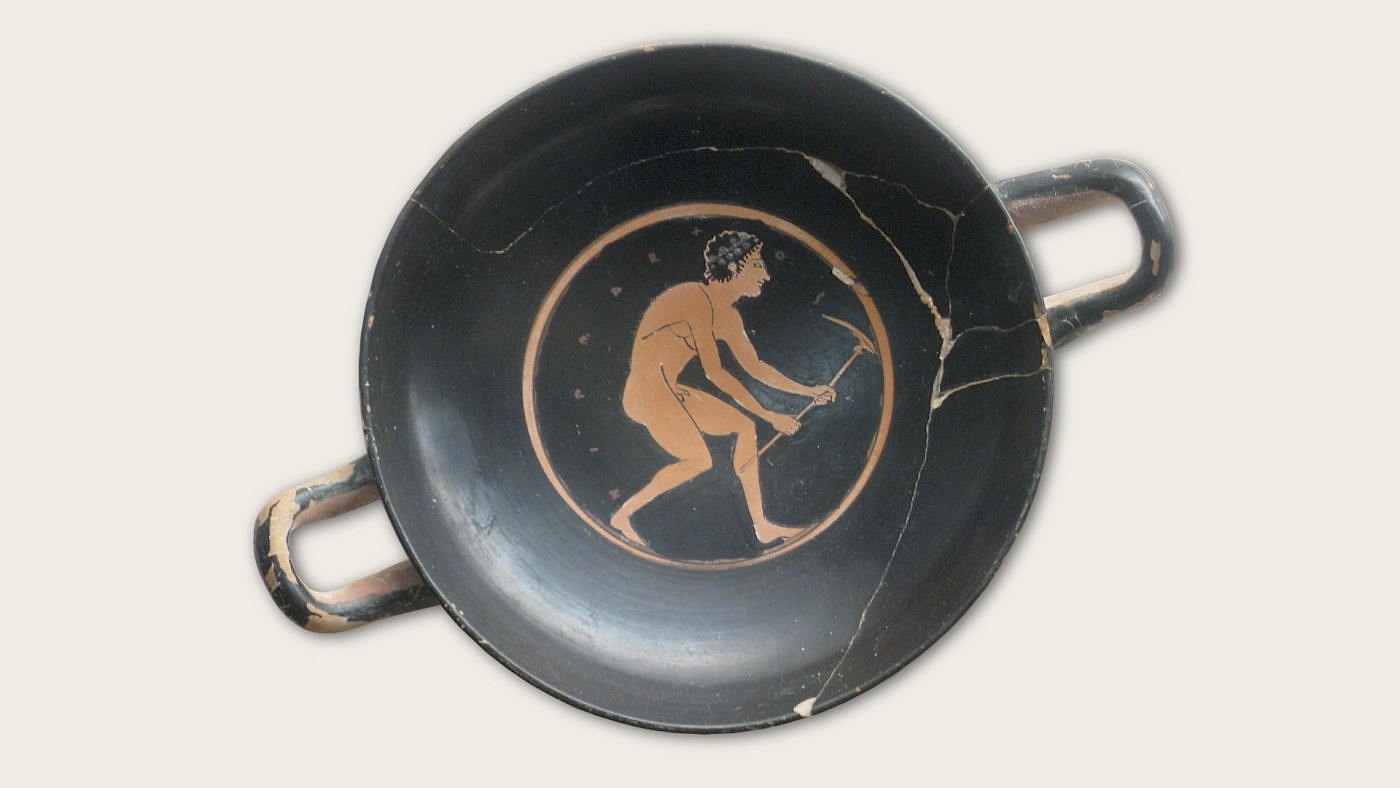I took the picture at the top of this article at the Archaeological Museum of Rhodes. It is a kylix or cup, dated to ca. 520-500 BC and made, according to the description at the museum, “in the manner of Epiktetos”. This means that scholars believe that the cup’s style is like that of the painter Epiktetos. I wrote an earlier article on coinnorseurship and its problems.
The circular scene at the centre on the inside of the cup, the so-called tondo, depicts a young athlete flattening the ground with a hoe. We are to imagine that he is doing so in the palaestra. The palaestra was a small(ish) area, often covered with sand and often part of a larger gymnasium, where athletes could exercise. The sports that they engaged in did not need a lot of space: imagine them wrestling, boxing, and so on.
Of course, as athletes exercised they disturbed the surface of the palaestra. As a result, one would have to even things out every once in a while. This cup suggests that the athletes would do this themselves. We know the youth is an athlete because he is naked: ancient Greeks practiced sports in the nude. Indeed, the word “gymnasium” (Greek: γυμνάσιον) derives from ancient Greek γυμνός, “naked”. He also wears a wreath on his head; a symbol of victory.
The cup features a name, Hipparchos. We are perhaps to imagine that the young man with the hoe is this Hipparchos. His name, a combination of the Greek words for “horse” and “leader”, is typical of the upper echelons in society. The cup combines the image of an attractive youth with a name that belongs to the well-to-do of Greek society. It is thus a so-called kalos cup.
The word kalos (“good”) is sometimes included on these types of vessels. Such vessels are always associated with the consumption of alcohol. We should imagine men drinking at a symposium and toasting to the good looks and other virtues of certain young men. Same-sex relations between an older man and a teenager or adolescent – referred to as pederasty – were common in Greek high society.
Archaeologists unearthed the cup in Kamiros, Macri Langoni. It was originally made in Attica, on the other end of the Aegean Sea. The fact that this cup found its way to Rhodes suggests that the people here found it to their liking. It’s hard to tell if it was ever used before someone placed it in a grave. Are we to imagine that the deceased’s name was Hipparchos? Or had the deceased been in love with a youth called Hipparchos? It’s hard to tell without further information.
It’s important to note that pederasty was, for all intents a purposes, an institutionalized form of paedophilia. Certain texts, like those by Plato, tend to downplay the sexual element in these relationships. But you don’t have to be a cynic to believe that often sex was part of the deal. For example, some vase-paintings depict the older man fondling the testicles of the boy. Others show him embracing the boy. See, for example, Ross Brendle’s article “The pederastic gaze in Attic vase-painting”, Arts 8.2 (2019).
Some may regard the scene as an innocent depiction of a youth working in the palaestra. But within the context of kalos vases in general, we should probably interpret it as as erotic image. After all, this is a handsome – “good” – boy. His genitals are visible and his eye seems to gaze at the onlooker. If held in the right way, draining the cup of wine would have meant that you would, sooner or later, come eye to eye with young Hipparchos.
It is easy to regard the ancient Greeks as enlightened, not prone to falling to human foibles. Such is, of course, utter nonsense. There is no reason to believe that monsters like the late Jeffrey Epstein are a modern aberration. Of course, we have no sources about the trauma that boys and young men in ancient Greece suffered at the hands of older “benefactors”. But we cannot gloss over pederasty as a normal phenomenon, devoid of any value judgements.
As much as we may admire the art of the ancient world, it’s the context that gives it meaning. A kalos vessel like this should make us queasy, and force us to confront the darker aspects of ancient societies. Only this way can we come to terms with humanity as a whole, and forge a better path forwards.
